Heydon: Brucella ovis tests remain a requirement in sheep exports
Testing for Brucella Ovis in male sheep will remain a requirement when exporting lambs, according to Minister for Agriculture, Food and the Marine, Martin Heydon.
The minister was responding to a parliamentary question from Sinn Féin TD, Martin Kenny.
Minister Heydon said that under EU Animal Health Law legislation, sheep being moved to another EU country must have a negative blood test for Brucella ovis.
According to the minister, live male lambs moving to another member state, particularly The Netherlands, require a clear test within a 30-day period prior to movement.
He said this also applies to uncastrated lambs intended for fattening, as they are "theoretically 'breeding animals".
Minister Heydon said: "I am aware that trade of live animals continues to be important to Irish farming and that it is highly valued by the farming community as it provides an alternative market outlet."
Because Ireland holds a long-established Brucella ovis-free status, Minister Heydon said the Department of Agriculture, Food and the Marine (DAFM) had raised this issue of required testing with the EU Commission.
DAFM requested that "delegated Regulation 2020/688 be amended so that Brucella ovis blood testing is not required for uncastrated male sheep which are ultimately intended for slaughter but may require a period of fattening."
In his reply to Deputy Kenny, Heydon stated: "The Commission have concluded, having considered current scientific opinion and International standards, that the current EU requirements are proportionate and therefore this testing requirement remains in place."
Brucella ovis is an infection that causes a clinical or subclinical disease called ovine epididymitis in sheep.
The disease causes genital lesions and reduced fertility in rams, as well as placentitis and abortion in ewes, some of the main key performance indicators (KPIs) for the animals.
The disease is also known to cause an increase in perinatal mortality.
The disease is generally known to spread via excreted semen from infected rams, as well as ram-to-ram transmission.
According to the World Organisation for Animal Health (WOAH) , the disease can also spread from ram-to-ram and through milk or vaginal discharge of an ewe.
Brucellosis is a notifiable disease in Ireland, and any farmer who suspects their livestock may have the disease is required by law to contact DAFM.





